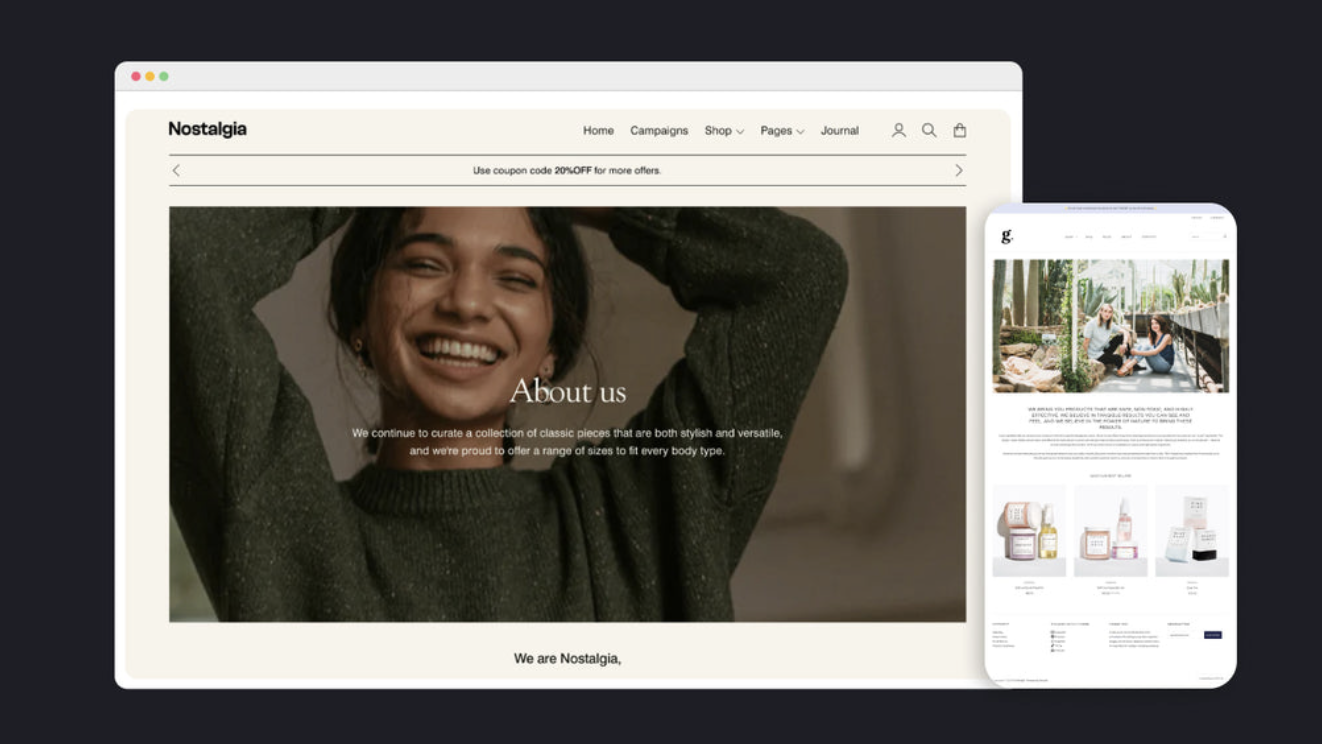
E-commerce brand storytelling isn’t a marketing trick. It’s your secret weapon. While everyone else is out here yelling about discounts and features, you’re about to give people something they actually care about , a reason to remember you.
In a world of scrolls, swipes, and one-second attention spans, a good product might win a click. A good story wins a customer.
We’re not just talking fluff here. Storytelling taps into the one thing AI, templates, and endless product specs can’t fake: emotion. And that’s what people buy with. Every time.
People buy with emotion, justify with logic
Here’s how it goes: a customer reads your story. They feel something. A connection. A spark. Nostalgia. Curiosity. Then they click “Add to Cart.” Only after that do they go, “It’s organic,” or “It has free shipping,” or “Well, I did need new socks.”
The story made the sale. The features just sealed the deal.
Why storytelling builds brand memory (and why you want that)
Do you remember the ad with the bullet-point list of product features? Neither does anyone else.
But you do remember the brand that made you laugh. Or cry. Or think. You remember the founder who turned a side hustle into a movement. You remember the brand that stood for something.
That’s what e-commerce brand storytelling does , it imprints you in someone’s brain before they buy, and long after the package arrives.
Your story is your differentiator , not your product
Let’s be honest: someone else out there probably sells something kinda like you. Same function, same price point, maybe even same supplier.
But they’re not you.
They don’t have your founder story. They don’t have your brand values. They don’t have that one moment that sparked the business in the first place. And if you don’t tell that story… your customer won’t know the difference.
It’s the fastest way to trust (and trust leads to sales)
People don’t want to be sold to. They want to feel seen. They want to believe that you get them , their struggles, their values, their dreams.
Storytelling bridges that gap.
The right story:
- Makes your brand relatable
- Makes your product feel right for someone’s life
- Reduces skepticism without a hard sell
- Builds that invisible “I trust this brand” feeling
And guess what? Trust is what turns one-time buyers into loyalists who not only come back… but bring friends.
The rise of emotional marketing in e-commerce
The brands winning in 2025 aren’t the loudest , they’re the most human. They’re the ones that stop you mid-scroll with a story that hits.
That’s why emotional marketing for e-commerce is on fire right now. It’s not about selling features. It’s about selling feelings , connection, transformation, identity.
Examples:
- A wellness brand sharing how their founder overcame anxiety
- A home decor shop spotlighting real customers transforming their first apartments
- A sustainable clothing line telling the story of a garment’s journey from fabric to finish
These aren’t just posts. They’re emotional touchpoints that stick.
What this means for your Shopify store
If your product pages are just bullet lists, if your About page reads like a résumé, if your emails don’t sound like you , then you’re leaving serious connection (and cash) on the table.Injecting e-commerce brand storytelling into your site and your content isn’t about being sentimental. It’s about being strategic. Because when your story resonates, customers don’t just buy once… they belong.

How to Craft an E-commerce Brand Storytelling Framework for Your Origin
Let’s be real: if your origin story starts with “We noticed a gap in the market,” go ahead and pour yourself a decaf , because no one’s sticking around for that.
E-commerce brand storytelling begins with something more real. More raw. Something your customers can feel.
You don’t need a Hollywood plot twist. You need honesty with a heartbeat , the moment when your “I should probably do this” became “I can’t not do this.”
Your ‘why’ is the soul of your brand , tell it like you mean it
The best stories don’t just explain what you sell. They explain why you exist. That “why” is what customers connect to.
Ask yourself:
- What problem did you experience firsthand?
- What pissed you off enough to fix it?
- What made you risk time, money, sleep, and your social life to build this thing?
That’s not just your backstory , it’s your bond.
Founder’s story Shopify customers actually care about
Customers don’t need your entire life story. They need the moment. The turning point.
Paint a picture of:
- The late-night frustration
- The random napkin sketch
- The family dinner when the idea first dropped
- The prototype that failed five times before it worked
Real beats polished. Every. Single. Time.
Example: “I started this brand after spending $200 on a pair of leggings that fell apart in three washes. So I made a pair that wouldn’t.”
That’s it. That’s the story. No fluff. Just fire.
Align your story with your customer’s values (because it’s not just about you)
Yes, it’s your story. But it’s about them.
Good e-commerce brand storytelling mirrors your customer’s world. Their needs. Their beliefs. Their journey.
Tie your brand’s mission to values your audience already holds:
- Sustainability
- Self-expression
- Mental health
- Confidence
- Community
- Empowerment
You’re not just telling your origin. You’re giving your customer a reason to say, “That’s my kind of brand.”
Use the “Struggle → Spark → Solution” framework
This works. Every time.
- Struggle , What was wrong? What pain or frustration existed?
- Spark , What moment made you take action?
- Solution , What did you build? And how does it help?
This three-part arc keeps your story simple, emotional, and sticky. Plus, it sets you up perfectly for the rest of your messaging.
Don’t forget to show growth , people root for momentum
Let your audience know where you started… and where you are now.
Were you:
- Packing boxes in your garage?
- Learning Shopify by watching YouTube tutorials at 2am?
- Driving cross-country to pitch a retail store?
Great. Share that. Because people don’t just love underdogs. They love watching them win.
Put your story everywhere , not just the About page
Once your origin story is dialed, use it:
- On your homepage (“Why we started”)
- In welcome emails
- In ad copy
- On packaging inserts
- At the start of your product descriptions
- And in your content… always in your content
Consistency = credibility. When your story stays the same, people start to believe it. And more importantly , they start to remember it.

Where to Use E-commerce Brand Storytelling on Your Shopify Store
You’ve crafted your e-commerce brand storytelling masterpiece. Great. Now what? You don’t just bury it in your About page and hope someone finds it while scrolling at midnight. You embed that story everywhere your customers show up.
Your story isn’t background noise , it’s the script playing on every page that gets people to buy, believe, and come back.
Here’s where it belongs.
Homepage: Set the tone in the first scroll
You’ve got three seconds to grab attention. Don’t waste them on “Welcome to our store.”
Instead, lead with your story’s most relatable line. Think:
- “We started this brand in a tiny apartment after our favorite moisturizer was discontinued.”
- “Tired of throwing away $30 candles, we made one that actually burns to the bottom.”
Add a photo that feels real , your first setup, a customer using the product, or even a side-by-side of “before we started” vs. now.
Bonus: Add a callout button that says “Our Story” right there. Let them opt in. That curiosity? It’s fuel.
About Page: The full story , without the fluff
This is where your Shopify brand narrative gets to breathe.
Structure it like a Netflix pilot:
- What sparked the brand
- Who’s behind it (founder, team, dog, anyone real)
- What you stand for (values, mission, purpose)
- Where you’re going (hint: customers are invited along)
Use real photos, not stock. Write like you talk. And if you have a “bad idea turned big win” moment? Lead with it.
Product Pages: Make them story-driven, not spec-driven
Here’s where most e-commerce brands drop the ball. They treat product pages like tech specs.
You? You’re telling a micro-story.
Include:
- Why you made it
- What problem it solves (make it emotional)
- A line about the journey: “This took us 6 failed prototypes to get right , worth it.”
- Customer quotes that sound human, not staged
- Lifestyle images that show the product in the customer’s world
Story-driven product pages turn skimmers into buyers. And buyers into brand fans.
Checkout Page & Confirmation Email: Reinforce the relationship
At this point, they’ve clicked “Buy.” That’s a big deal. Don’t just give them a receipt , give them a reminder that they’re now part of something.
Try this on your thank-you page or confirmation email:
- “You’re now part of our journey. We started this brand with $400 and a dream. Every order helps us keep growing, one happy customer at a time.”
It’s a soft close to a strong story. It leaves them feeling good. And it sets the stage for their next interaction.
Bonus: Use stories in tooltips, banners, and micro-copy
Anywhere you can add a human voice, do it.
Examples:
- Under a product image: “Designed after a late-night customer email that said, ‘I wish this came in black.’”
- On a shipping banner: “Yes, it’s free shipping , because we remember when we couldn’t afford it either.”
- Tooltip on sizing: “We tested these on 11 different body types. You’re probably one of them.”
It’s not about adding text. It’s about adding texture.
Consistency is everything
Your story loses power if it changes from page to page.
Once you’ve nailed your e-commerce brand storytelling tone , stick to it. Use it across:
- Homepage
- About
- Product
- Checkout
- Emails
- Ads
- Everywhere your customers meet your brand
The more places they see it, the more they believe it. And once they believe it… they trust you.

https://gempages.net/blogs/shopify/shopify-about-us-page
Using E-commerce Brand Storytelling in Email, Ads, and Social Media
If your emails sound like a robot wrote them and your ads look like they were auto-generated by a plugin… congratulations, you’re blending in perfectly with everyone your customers scroll past.
Let’s fix that.
E-commerce brand storytelling isn’t just for your website. It belongs in every inbox, feed, and swipe-up. When done right, it turns campaigns into conversations , the kind that get remembered and clicked.
Email: Don’t just send info , send a story
Forget the “20% OFF ENDS TONIGHT” email subject lines. You’re not running a clearance rack. You’re building a brand.
Use your emails to deliver bite-sized chapters of your story.
Here’s how:
- Welcome series: Tell your founder’s story in a three-part arc (struggle, spark, solution)
- Product launches: Share the backstory , “We made this based on 487 customer DMs”
- Customer spotlights: Frame reviews as journeys (“Jenna’s skincare routine before & after she found us…”)
- Behind-the-scenes: Show your team, your process, the why behind what you’re doing
Use storytelling in your headers, body copy, and even your P.S. lines. It’s the details that keep people reading.
Ads: Your 3-second story hook starts now
People don’t scroll social looking for ads , they scroll looking for stories. So give them one.
Your ad copy should follow a mini narrative arc:
- Problem: “Tired of candles that burn out in two nights?”
- Tension: “We were too , and we tested 37 wicks to fix it.”
- Solution: “Meet the candle that lasts 3x longer and smells like vacation.”
Then add a visual that feels human. A real user. A messy desk. A screenshot of a 5-star review with heart emojis. Ads that feel like posts? They win.
Social media: Your storytelling playground
Social is where your e-commerce brand storytelling gets to stretch its legs. You don’t have to deliver the whole plot in one post , you get to build it over time.
Try this:
- Instagram Stories: “A day in the life” behind the scenes
- Reels: The moment your product solved something real
- Carousels: Tell the full journey , from pain point to product to happy customer
- Captions: Use storytelling tone even when you’re announcing a sale
- Pinned posts: Your founder story or first product launch moment
Want more engagement? Start the story, then invite your followers to finish it:
“We created this for people who ___ , sound like you?”
Suddenly, you’re not just storytelling. You’re story-building with your audience.
Turn UGC into micro-stories, not just pretty pictures
Your customers are sitting on gold , but only if you frame it right.
Take a customer photo and tell the story:
- Why they bought
- What problem it solved
- How it made them feel
- What happened next
“Rachael bought our planner after missing three Zoom calls in a week. One month later, she’s the most organized person in her office. We can’t prove it helped her land a promotion, but… the timing lines up.”
Now that’s content people connect with. That’s e-commerce brand storytelling at its finest.
Inject story DNA into all your campaigns
Whether it’s Black Friday, a spring drop, or your anniversary sale, there’s always a story angle.
- “Last year we nearly sold out in 6 hours , this year, we’re ready.”
- “We designed this collection during a team retreat in the middle of nowhere.”
- “You told us what you wanted. We listened. Now it’s live.”
Story gives your campaigns dimension. Without it, they’re just another promotion. With it, they’re a moment.

How to Keep Your E-commerce Brand Storytelling Real and Relatable
Here’s a hard truth: customers can smell BS through a screen. They know when a brand’s story is scripted like a made-for-TV movie. And nothing kills trust faster than trying too hard.
The best e-commerce brand storytelling doesn’t sound like marketing. It sounds like something your smartest, funniest friend might say if they were pitching you a product over coffee.
So how do you keep your story real? Like, “I’d forward this email to a friend” real?
Start with real people , not personas
You don’t need a fake founder voice or a fictional customer journey. You need you. And your actual customers.
Use:
- Quotes from real feedback
- Photos of your team on launch day, not a Shutterstock photo of people high-fiving
- True stories, even if they’re messy
People relate to flaws. To stumbles. To figuring it out as you go. That’s how you earn brand authenticity and trust , not by being perfect, but by being honest.
Stop writing like a brochure
Nobody talks like this:
“At [BrandName], we’re passionate about delivering premium quality solutions for discerning online consumers.”
Please. If you wouldn’t say it out loud, don’t write it on your website.
Say this instead:
“We made this because the alternatives were either overpriced or ugly. Usually both.”
Keep it human. Conversational. Like your brand has a face , not just a font.
Use emotional triggers , but don’t manipulate
Good e-commerce brand storytelling taps into feelings. But there’s a fine line between connecting and manipulating.
The right kind of emotional marketing for e-commerce includes:
- Hope (“We believe everyone deserves a daily routine that feels good.”)
- Curiosity (“We wondered what would happen if we removed every single unnecessary ingredient.”)
- Struggle (“We almost quit after prototype #4… glad we didn’t.”)
- Triumph (“Now we’ve got 10,000 customers , and we still hand-pack every box.”)
What it doesn’t include:
- Overhyped claims
- Trauma bait
- Exaggerated success stories that make your audience roll their eyes
Keep it grounded. Keep it true.
Less polish, more personality
Perfectly polished copy and design might look nice, but it often feels sterile. What stands out now? Personality.
Add:
- A quirky detail in your product description
- A founder anecdote in your email footer
- A behind-the-scenes fail story on Instagram
- A handwritten note in your packaging that says, “This box was packed by Jake. He likes dogs and revenge thrillers.”
That little dose of you makes your brand feel alive.
Let your customers tell your story , in their own words
Sometimes, your best storytelling doesn’t come from you at all. It comes from your people.
Use UGC and testimonials as story fuel. Not just to say “Look at these happy buyers,” but to show:
- Where they were before
- What they needed
- What they got from you
- How it changed their day, week, or mindset
Now you’ve turned a review into a mini movie , and one your future buyers can see themselves in.
Don’t be afraid to laugh at yourself
Nothing builds trust like a little self-deprecating humor. Show the moments where things didn’t go as planned:
- The time your website crashed mid-launch
- The packaging design your mom hated
- The early product name that sounded like a prescription drug
When customers see you don’t take yourself too seriously, it makes them take you more seriously. Weird how that works , but it does.
Gut-check everything with this question: “Would I actually say this to a customer in person?”
If the answer is no , rewrite it.

How Cirius Marketing Builds E-commerce Brand Storytelling That Converts
You’ve got a story. Maybe even a great one. But if it’s sitting quietly on your About page while the rest of your brand speaks in generic headlines and promo-speak, then we need to talk.
Cirius takes your raw story and turns it into a full-blown conversion machine. Because e-commerce brand storytellingshould do more than sound nice , it should move the needle.
Here’s how we make that happen.
We start with a founder interview , and we don’t ask surface-level questions
Before we write a single word, we dig in.
Not just:
- “What inspired the brand?”
But also: - “What scared you most when you launched?”
- “When did you know this was going to work?”
- “What’s something you do differently , and why does it matter?”
We’re not looking for stock answers. We’re pulling out the moments that shape your mission. Then we distill that into a brand narrative that’s both emotionally resonant and strategically usable.
We build your storytelling framework into every page of your site
Once we’ve got your brand story locked, we don’t just hand it to you in a PDF and bounce. We thread it into:
• Homepage hero copy that hooks instantly
• An About page that doesn’t read like a résumé
• Story-driven product pages that sell the transformation, not just the features
• Checkout copy that reinforces trust
• “Thank You” emails that don’t feel like receipts , they feel like relationship builders
Every single touchpoint becomes part of the story. It’s not “branded.” It’s alive.
We write email flows and sequences that tell a story , not just chase clicks
Your emails should read like your favorite mini-series: bingeable, satisfying, and just personal enough to feel like they were written for one.
We create:
- Welcome series built around your founding story
- Abandoned cart flows that remind people why they wanted the product in the first place
- Product launch emails with origin-style behind-the-scenes
- Customer spotlight emails that share real user journeys
- Post-purchase series that reinforce brand values and community
We don’t write “sales copy.” We write brand chapters.
We align your storytelling with visuals, voice, and brand vibe
Copy without design is half the story. So we collaborate with your brand team (or ours, if you need it) to make sure your storytelling matches your look, feel, and tone.
That means:
- Visual direction for your site and product photography
- Social media templates that carry your voice across formats
- Branded Canva kits for your team or influencers
- Storyboarding for campaign launches and reels
Your storytelling doesn’t live in a vacuum. We make sure it echoes across every scroll and swipe.
We test, optimize, and tweak for conversion , because feelings are great, but sales are better
Storytelling is emotional. But this is e-commerce, not story hour.
That’s why we track how your e-commerce brand storytelling actually performs.
We measure:
- Scroll depth on your About and homepage
- Click-through rates on email stories vs. promo-only content
- UGC and social share rates
- AOV and conversion rate changes post-story integration
- Time-on-page increases on story-driven product descriptions
Then we tweak headlines, rearrange sections, rewrite CTAs , whatever gets more people to feel and then buy.
Real results: From ‘cool brand’ to conversion king
A Shopify brand came to us with a product people liked, but a site that felt… soulless.
We built a storytelling framework around their founder’s scrappy journey, redesigned their homepage to lead with emotion, and rewrote their top-selling product page like a mini-movie.
Within 60 days:
- Time on site jumped 34%
- Conversion rate increased by 22%
- Customer emails started with, “I love your story…”
- And their returning customer rate hit a 12-month high
They didn’t add new SKUs. They didn’t change their pricing.
They just started telling the right story, the right way.

Ready to turn your story into your strongest sales tool? Book a Complimentary Growth with Cirius Marketing
